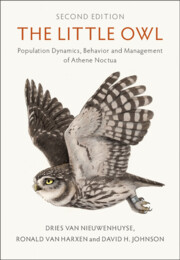Book contents
- The Little Owl
- The Little Owl
- Copyright page
- Contents
- Foreword
- Preface
- Acknowledgements
- Executive Summary
- Chapter 1 Introduction: Framework
- Chapter 2 History and Traditions
- Chapter 3 Fossil Evidence, Taxonomy and Genetics
- Chapter 4 Morphology and Body Characteristics
- Chapter 5 Distribution, Population Estimates and Trends
- Chapter 6 Habitat
- Chapter 7 Diet
- Chapter 8 Breeding Season
- Chapter 9 Behavior
- Chapter 10 Population Regulation
- Chapter 11 Management and Conservation
- Chapter 12 Research Priorities
- References
- Index
Chapter 8 - Breeding Season
Published online by Cambridge University Press: 29 September 2023
- The Little Owl
- The Little Owl
- Copyright page
- Contents
- Foreword
- Preface
- Acknowledgements
- Executive Summary
- Chapter 1 Introduction: Framework
- Chapter 2 History and Traditions
- Chapter 3 Fossil Evidence, Taxonomy and Genetics
- Chapter 4 Morphology and Body Characteristics
- Chapter 5 Distribution, Population Estimates and Trends
- Chapter 6 Habitat
- Chapter 7 Diet
- Chapter 8 Breeding Season
- Chapter 9 Behavior
- Chapter 10 Population Regulation
- Chapter 11 Management and Conservation
- Chapter 12 Research Priorities
- References
- Index
Summary
This chapter covers the entire Little Owl breeding cycle. The breeding season is obviously a critically important period during which reproduction can be influenced by many different factors, such as weather, food, habitat, density, geographical location and parental experience. The season begins in January or February with the affirmation of territorial boundaries and onset of courtship. The Little Owl does not have high a productivity due to very few replacement clutches, moderate fledging success and relatively high egg failure. According to the mortality rate of adults and juveniles, each pair should produce between 1.7 and 2.34 fledged young per year to compensate mortality and actually most of the long-term breeding studies across Europe show results ranging between both values. Analysis of consistently organized long-term demographic data has enhanced our understanding of Little Owl population dynamics. Further, this demographic data has been linked to specific habitat conditions at the nest site, home range and landscape scales. We offer clarification of the terminology related to nesting success and reproduction due to its importance in providing an accurate and consistent foundation for the data that will be used to assess the reproductive performance of the owls, as well in long-term monitoring of status and trends.
Keywords
- Type
- Chapter
- Information
- The Little OwlPopulation Dynamics, Behavior and Management of <I>Athene noctua</I>, pp. 324 - 385Publisher: Cambridge University PressPrint publication year: 2023



